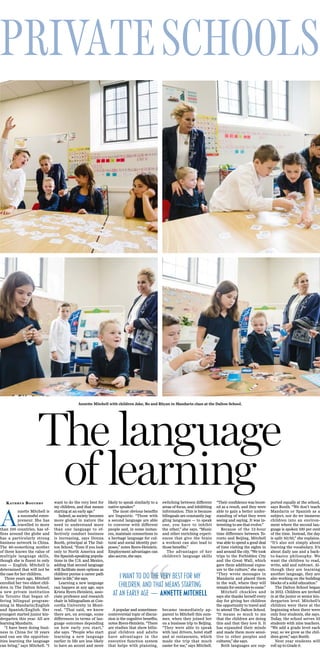
Articlenationalpost
- 1. Kathryn Boothby A nnette Mitchell is a successful entre- preneur. She has travelled to more than 100 countries, has of- fices around the globe and has a particularly strong business network in China. The 40-something mother of three knows the value of multiple language skills, though she is fluent in only one — English. Mitchell is determined that will not be the case for her children. Three years ago, Mitchell enrolled her two eldest chil- dren in The Dalton School, a new private institution in Toronto that began of- fering bilingual program- ming in Mandarin/English and Spanish/English. Her youngest started junior kin- dergarten this year. All are learning Mandarin. “I have been doing busi- ness in China for 19 years and can see the opportun- ities learning the language can bring,” says Mitchell. “I want to do the very best for my children, and that means starting at an early age.” Indeed, as society becomes more global in nature the need to understand more than one language to ef- fectively conduct business is increasing, says Donna Booth, principal at The Dal- ton School. “Even if you look only to North America and the Spanish-speaking popula- tions in the U.S. and Mexico, adding that second language will facilitate more options as children pursue a career path later in life,” she says. Learning a new language can happen at any age, says Krista Byers-Heinlein, asso- ciate professor and research chair in bilingualism at Con- cordia University in Mont- real. “That said, we know there are, on average, some differences in terms of lan- guage outcomes depending on how early you start,” she says. “People who start learning a new language earlier in life are less likely to have an accent and more likely to speak similarly to a native speaker.” The most obvious benefits are linguistic. “Those with a second language are able to converse with different people and, in some instan- ces, maintain connections to a heritage language for cul- tural and social identity pur- poses,” notes Byers-Heinlein. Employment advantages can also accrue, she says. A popular and sometimes- controversial topic of discus- sion is the cognitive benefits, notes Byers-Heinlein. “There are studies that show bilin- gual children and adults have advantages in the executive function system that helps with planning, switching between different areas of focus, and inhibiting information. This is because bilinguals are constantly jug- gling languages — to speak one, you have to inhibit the other,” she says. “Music and other enriching experi- ences that give the brain a workout can also lead to those benefits.” The advantages of her children’s language skills became immediately ap- parent to Mitchell this sum- mer, when they joined her on a business trip to Beijing. “They were able to speak with taxi drivers, hotel staff and at restaurants, which made the trip that much easier for me,” says Mitchell. “Their confidence was boost- ed as a result, and they were able to gain a better under- standing of what they were seeing and saying. It was in- teresting to see that evolve.” Because of the 12-hour time difference between To- ronto and Beijing, Mitchell was able to spend a good deal of time visiting the sights in and around the city. “We took trips to the Forbidden City and the Great Wall, which gave them additional expos- ure to the culture,” she says. “They wrote messages in Mandarin and placed them in the wall, where they will remain for centuries to come.” Mitchell chuckles and says she thanks herself every day for giving her children the opportunity to travel and to attend The Dalton School. “It means so much to me that the children are doing this and that they love it. It has expanded their minds and made them more sensi- tive to other peoples and cultures,” she says. Both languages are sup- ported equally at the school, says Booth. “We don’t teach Mandarin or Spanish as a subject, nor do we immerse children into an environ- ment where the second lan- guage is spoken 100 per cent of the time. Instead, the day is split 50/50,” she explains. “It’s also not simply about learning the vocabulary. It’s about daily use and a back- to-basics philosophy. We want the children to read, write, add and subtract. Al- though they are learning another language, they are also working on the building blocks of a solid education.” The Dalton School began in 2012. Children are invited in at the junior or senior kin- dergarten level. Mitchell’s children were there at the beginning when there were only four students, she says. Today, the school serves 53 students with nine teachers. “We add a grade level each year, so we grow as the chil- dren grow,” says Booth. Next year students will roll up to Grade 6. The language of learning PRIVATESCHOOLS I WANT TO DO THE VERY BEST FOR MY CHILDREN, AND THAT MEANS STARTING AT AN EARLY AGE — ANNETTE MITCHELL Annette Mitchell with children Jake, Bo and Rhyan in Mandarin class at the Dalton School.